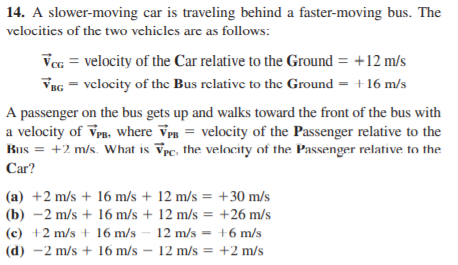14. A slower-moving car is traveling behind a faster-moving bus. The velocitics of the two vehicles are as follows: Vcc = velocity of the Car relative to the Ground = +12 m/s VBG = vclocity of the Bus relative to the Ground = +16 m/s A passenger on the bus gets up and walks toward the front of the bus with a velocity of Vr. where Vpn = velocity of the Passenger relative to the Bus = +2 m/s. What is Vpc, the velocity of the Passenger relative to the Car? (a) +2 m/s + 16 m/s + 12 m/s = +30 m/s (b) -2 m/s + 16 m/s + 12 m/s = +26 m/s (c) +2 m/s + 16 m/s 12 m/s = +6 m/s %3D (d) -2 m/s + 16 m/s – 12 m/s = +2 m/s
14. A slower-moving car is traveling behind a faster-moving bus. The velocitics of the two vehicles are as follows: Vcc = velocity of the Car relative to the Ground = +12 m/s VBG = vclocity of the Bus relative to the Ground = +16 m/s A passenger on the bus gets up and walks toward the front of the bus with a velocity of Vr. where Vpn = velocity of the Passenger relative to the Bus = +2 m/s. What is Vpc, the velocity of the Passenger relative to the Car? (a) +2 m/s + 16 m/s + 12 m/s = +30 m/s (b) -2 m/s + 16 m/s + 12 m/s = +26 m/s (c) +2 m/s + 16 m/s 12 m/s = +6 m/s %3D (d) -2 m/s + 16 m/s – 12 m/s = +2 m/s
College Physics
1st Edition
ISBN:9781938168000
Author:Paul Peter Urone, Roger Hinrichs
Publisher:Paul Peter Urone, Roger Hinrichs
Chapter3: Two-dimensional Kinematics
Section: Chapter Questions
Problem 67PE: An ice hockey player is moving at 8.00 m/s when he hits the puck toward the goal. The speed of the...
Related questions
Question

Transcribed Image Text:14. A slower-moving car is traveling behind a faster-moving bus. The
velocitics of the two vehicles are as follows:
Vcc = velocity of the Car relative to the Ground = +12 m/s
VBG = vclocity of the Bus relative to the Ground = +16 m/s
A passenger on the bus gets up and walks toward the front of the bus with
a velocity of Vr. where Vpn = velocity of the Passenger relative to the
Bus = +2 m/s. What is Vpc, the velocity of the Passenger relative to the
Car?
(a) +2 m/s + 16 m/s + 12 m/s = +30 m/s
(b) -2 m/s + 16 m/s + 12 m/s = +26 m/s
(c) +2 m/s + 16 m/s
12 m/s = +6 m/s
%3D
(d) -2 m/s + 16 m/s – 12 m/s = +2 m/s
Expert Solution
This question has been solved!
Explore an expertly crafted, step-by-step solution for a thorough understanding of key concepts.
This is a popular solution!
Trending now
This is a popular solution!
Step by step
Solved in 2 steps with 2 images

Recommended textbooks for you

College Physics
Physics
ISBN:
9781938168000
Author:
Paul Peter Urone, Roger Hinrichs
Publisher:
OpenStax College

Physics for Scientists and Engineers, Technology …
Physics
ISBN:
9781305116399
Author:
Raymond A. Serway, John W. Jewett
Publisher:
Cengage Learning

Physics for Scientists and Engineers with Modern …
Physics
ISBN:
9781337553292
Author:
Raymond A. Serway, John W. Jewett
Publisher:
Cengage Learning

College Physics
Physics
ISBN:
9781938168000
Author:
Paul Peter Urone, Roger Hinrichs
Publisher:
OpenStax College

Physics for Scientists and Engineers, Technology …
Physics
ISBN:
9781305116399
Author:
Raymond A. Serway, John W. Jewett
Publisher:
Cengage Learning

Physics for Scientists and Engineers with Modern …
Physics
ISBN:
9781337553292
Author:
Raymond A. Serway, John W. Jewett
Publisher:
Cengage Learning

Physics for Scientists and Engineers
Physics
ISBN:
9781337553278
Author:
Raymond A. Serway, John W. Jewett
Publisher:
Cengage Learning

Principles of Physics: A Calculus-Based Text
Physics
ISBN:
9781133104261
Author:
Raymond A. Serway, John W. Jewett
Publisher:
Cengage Learning

Glencoe Physics: Principles and Problems, Student…
Physics
ISBN:
9780078807213
Author:
Paul W. Zitzewitz
Publisher:
Glencoe/McGraw-Hill